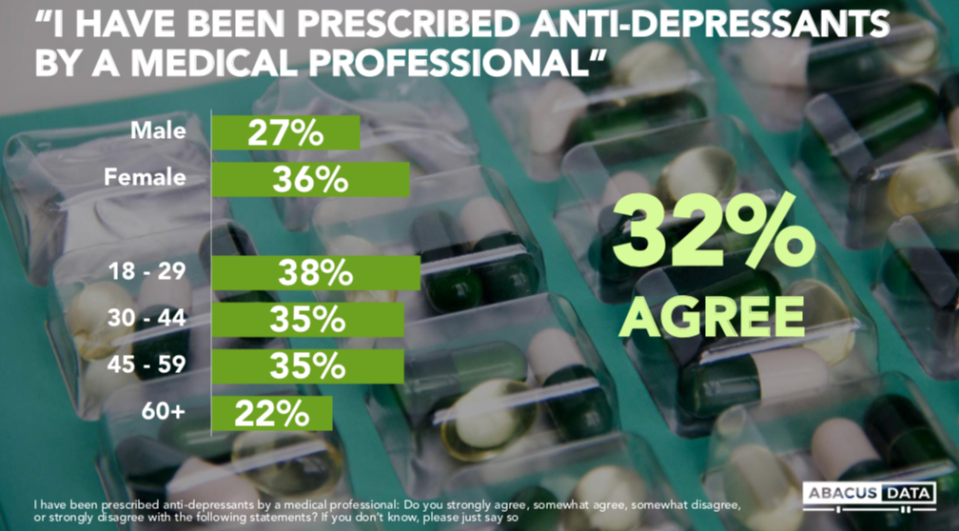Does anxiety affect more women than men? Statistics might not tell the whole story

Anxiety may not discriminate — it can affect anyone, regardless of their age or race — but it certainly impacts men and women differently.
Marked by extreme and consistent worry, anxiety appears to affect more women than men. According to a new Abacus Data forYahoo Canada survey, 71 per cent of females under 30 consider themselves someone who struggles with the condition, compared to 53 per cent of males.
More women than men have been diagnosed by a medical professional as having anxiety (36 per cent compared to 24 per cent, respectively), and Abacus also found more women than men have been prescribed antidepressants to help treat anxiety (36 per cent versus 27 per cent, respectively).
The Canadian Mental Health Association (CMHA), meanwhile, states that women are almost twice as likely as men to develop generalized anxiety disorder (GAD).
It’s not clear why anxiety is more common in women than men, but research points to some potential contributing factors.

ALSO SEE: Anxiety and wealth: ‘The fact that they’re anxious means that their lives aren’t perfect’
Some research suggests that anxiety could be related to hormonal changes, says CMHA policy analyst Leyna Lowe, who has a doctorate in women’s studies. She’s quick to point out that this hypothesis needs to be taken with caution; the onset of anxiety tends to happen in girls more markedly between the ages of nine and 13, typically when they’re going through puberty. However, Lowe says, “it’s difficult to untangle some of the social factors girls will experience from the biological factors. There’s a gender socialization component to experiences of anxiety. In western culture, the expression of anxiety is seen as being inconsistent with the male gender role….Fearful behaviour in boys and men might be less tolerated. For girls, parents, teachers, and peers, and the media might play a role in reinforcing assertiveness in boys and anxious behaviours in girls.”
Another possible explanation could be that women face different kinds of oppressions than men, Lowe notes. Women experience higher levels of violence, and there’s an association between childhood experience of violence and sexual abuse and the onset of anxiety.
Financial strain could be associated with the higher rate of anxiety among women too; poverty disproportionately affects women in Canada, and it’s a factor that can also impact mental health.
While statistics point to higher rates of anxiety in women and men, numbers may not tell the whole story.
ALSO SEE: How does religion impact anxiety?
Dr. Russell Kennedy, a Victoria, B.C. medical doctor who also has a degree in neuroscience, has dealt with anxiety himself since his teens. The founder of TheAnxietyMD.com and yoga instructor suspects that anxiety might even be more prevalent in men than women.

“I think men are much more likely to display anger and frustration, go into drugs and alcohol,” Kennedy says. “One of the biggest crimes we’ve done to our boys is not allow them to cry. If we’re taught that we can’t cry, we’re closing the door on one of best ways of integrating these negative emotions. Tears are a way of adapting to things we cannot change, and life is all about things we can’t change.
“Women are much more likely to talk about it and to seek help,” he says. “We assume that in men, depression and anxiety are signs of weakness.”
Women and men also tend to experience anxiety in different ways. Research suggests that men with anxiety report decreased pleasure, mood, and sense of enjoyment; they’re also likely to be more agitated, Lowe says. Women, by contrast, report symptoms of weight gain, gastrointestinal problems, waking up in the middle of the night with insomnia or obsessive thoughts, and signs of panic and phobias.
Other studies, Lowe says, have found that women who are diagnosed with anxiety are more likely to experience comorbid illness. That means they have a better chance of having another diagnosis, such as depression, an eating disorder, or another type of anxiety disorder.
What’s shared across genders when it comes to anxiety is the importance of seeking help. While there are different types of anxiety disorders, broadly speaking, anxiety is characterized by intense feelings of fear, dread, or distress that are out of proportion to reality. Physical symptoms can include muscle aches, tension, trembling, excessive sweating, shortness of breath, headache, stomach ache and heart palpitations.
According to the CMHA, treatment typically includes a combination of counselling (specifically cognitive behavioural therapy), medication, self-help, and support groups. (For men, Kennedy suggests a men’s group and online resources such as ManTalks.com.) Exercise, mindfulness, sufficient sleep, a healthy diet, and breathing exercises are among several worthwhile self-help strategies.

“Above all we say reaching out to other people is absolutely critical,” Lowe says. “Speaking to a loved one and speaking with your family doctor or any other health care professional can help to develop coping mechanisms and find potential treatments to soothe anxiety symptoms and recover.”
During the month of October, Yahoo Canada is delving into anxiety and why it’s so prevalent among Canadians. Read more content from our multi-part series here.
Let us know what you think by commenting below and tweeting @YahooStyleCA and follow us on Twitter and Instagram.
Abacus Data, a market research firm based in Ottawa, conducted a survey for Yahoo Canada to test public attitudes towards anxiety as a medical condition, including social stigmas and cultural impacts. The study was an online survey of 1,500 Canadians residents, age 18 and over, who responded between Aug. 21 to Sept. 2, 2019. A random sample of panelists were invited to complete the survey from a set of partner panels based on the Lucid exchange platform. The margin of error for a comparable probability-based random sample of the same size is +/- 2.53%, 19 times out of 20. The data was weighted according to census data to ensure the sample matched Canada’s population according to age, gender, educational attainment, and region.



